Ebook Việt Hoá] Plant parenting: Easy ways to make more houseplants vegetables and flowers - LESLIE F. HALLECK
[Ebook Việt Hoá] Plant parenting – LESLIE F. HALLECK (Nhân giống cây) – WATER ROOTING (Ra rễ dưới nước)
- Nguồn: [Ebook Việt Hoá] Plant parenting: E easy ways to make more houseplants, vegetables, and flowers – LESLIE F. HALLECK (Nhân giống cây: Những cách dễ nhất để nhân giống cây cảnh trong nhà, rau và hoa)
- Biên tập: Dũng Cá Xinh (Tháng 08/20201)
- Dịch: Huyền Nguyễn
English
Water rooting is often the gateway drug for those interested in making more plants. Most of you probably had a mother or grandmother with a collection of plant stems rooting in glass jars on the windowsill—with an avocado seed or two mixed in for fun. You may have gotten your own first try at plant propagation by water rooting some form of plant in school.
Lucky for you, many plant cuttings and some seeds don’t need soil or potting mix to root and grow new plants; all they need is water. Large seeds, such as those of avocado or oak acorns, can be suspended partially in water where they will sprout new roots. You may want to pre-soak your large seeds before you suspend them for water rooting.
Vegetative cuttings of many types of plants can be rooted by directly submerging stems in water. I recommend using soft, fleshy stem cuttings and leaf cuttings, which we’ll discuss in detail in the next chapter. Many tropical houseplants and fleshy garden perennials root easily in water. In fact, you can root many types of stem and leaf cuttings in both water and soil or other growing media. Depending on the type of plant, water rooting can often be faster than soil rooting, and it is more fun to watch.
Typically, woody and semi-woody plant material is harder to root in standing water, as it will often rot before it roots. You will usually have more success with woody or tough stem cuttings (i.e., citrus, gardenia, roses, other shrubs and trees) by using an organic or synthetic growing media, or an aeroponic propagator (cloner).
All you need is a windowsill to light most of your water-rooted cuttings. Until they develop roots and are ready to be transplanted, low-light conditions are just fine for these vegetative cuttings. Once the cuttings have developed roots and are ready to be transplanted, you’ll need to move the plant to the type of light conditions it traditionally favors. If you’re sprouting large seeds in water, such as avocados, remember that seedlings need brighter light than vegetative cuttings. Be sure to place emerging avocado seedlings in a bright window or use a grow light.
Use any type of glass or transparent container you’d like to water root your cuttings or seeds. Glass jars, vases, test tubes—a martini glass—you name it. They all work. There are also a few water root- ing accessories you can use for more successful water-propagation.
Ceramic and porcelain sprouting supports sit on top of a glass or jar, providing support for a large seed or vegetative cutting. Providing this support means the seed or cutting won’t sink into the water where it could drown and rot. These sprouting supports are also handy for rooting and forcing bulbs.
The old-school method for germinating avocado seeds in water is to stick three toothpicks into the seed, then suspend it on top of a glass jar. If you’re looking for a more modern approach, look for avocado seed floaters, which hold the seed and float it in a bowl of water.
When water rooting, be sure to change out fresh water as it becomes cloudy, until the plant has developed adequate roots. The type of water you use can make a difference in how well your plant roots and grows. City tap water will contain chorine, which is toxic to plants. Burnt looking or brown edges along your plant leaves can be a sign of chlorine toxicity. Tap water will also often have softeners such as sodium, which will damage your plants. If you can collect rain- water, you’ll find it to be ideal for rooting new cuttings and seeds. You can use spring water or well water, too. That said, if you only have access to tap water, go ahead and use it. You can naturally dechlorinate tap water by setting it out in a clear container in natural light for at least 24 hours.
The time it takes to root in water simply depends on the type of plant you’re growing. Certain fast-rooting species can root in only a few days; most plants will take a couple of weeks to develop roots, while others can take more than a month. Fleshy plants that develop aerial roots, such as philodendron are particularly easy and fast to water root. Plants with tougher stems will take longer. You can add small concentrations of rooting hormone, or root stimulators, to water that you use to root new plants. Be sure to follow label instructions for how much to use when mixing with water.
Once plants have developed roots that are 1 to 2 inches long and begin branching, it’s time to pot up your plant into a potting mix.
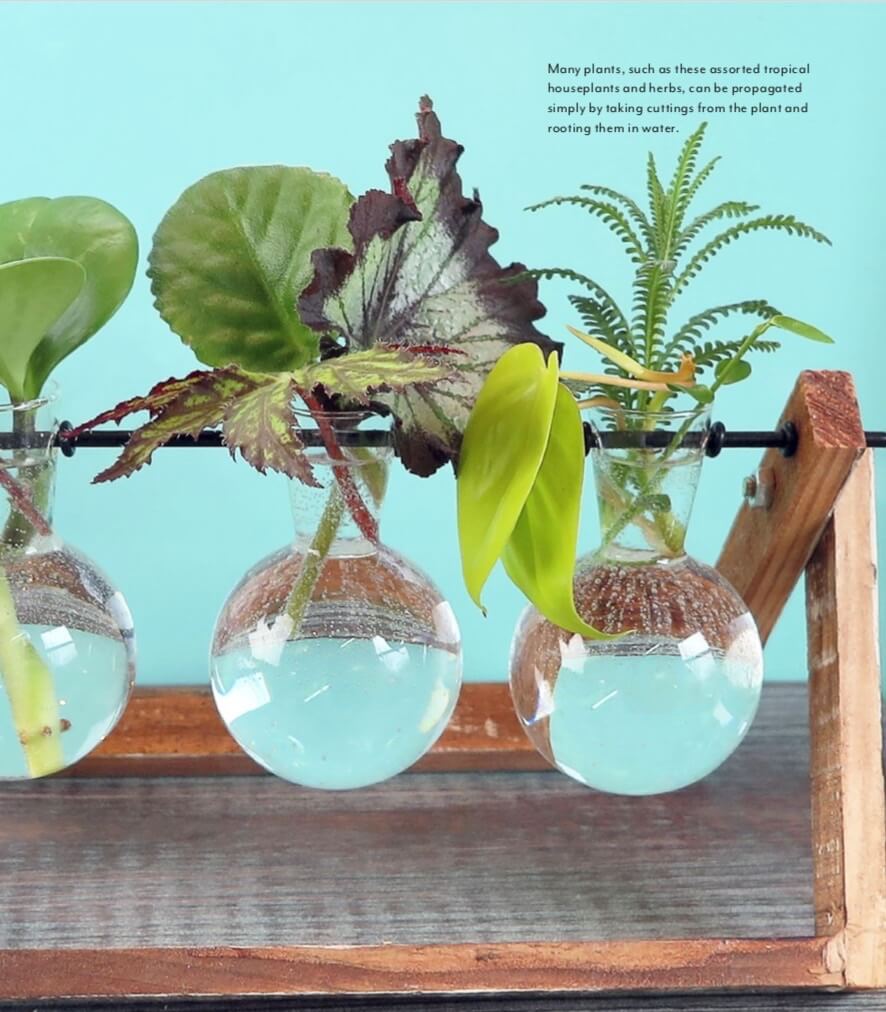
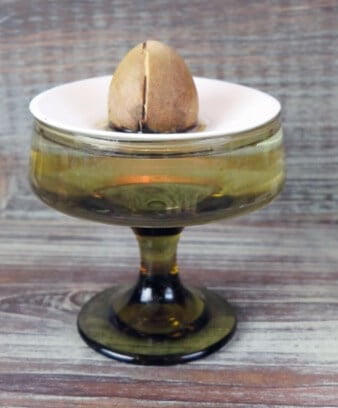
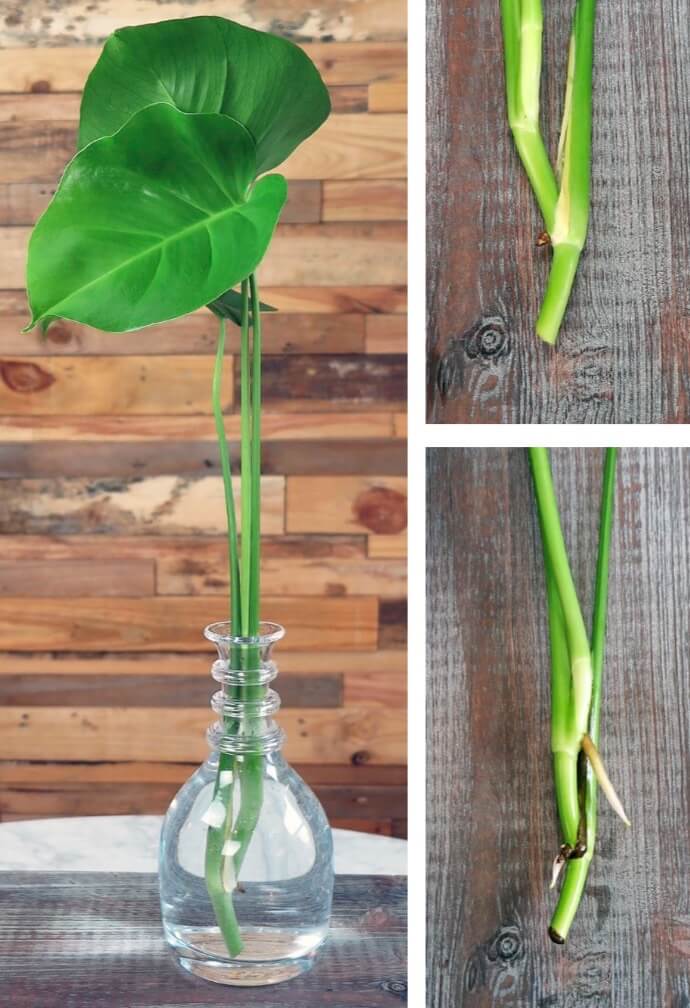
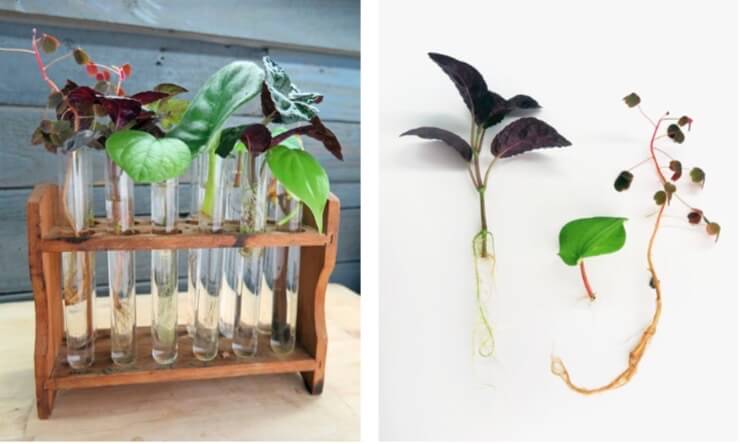
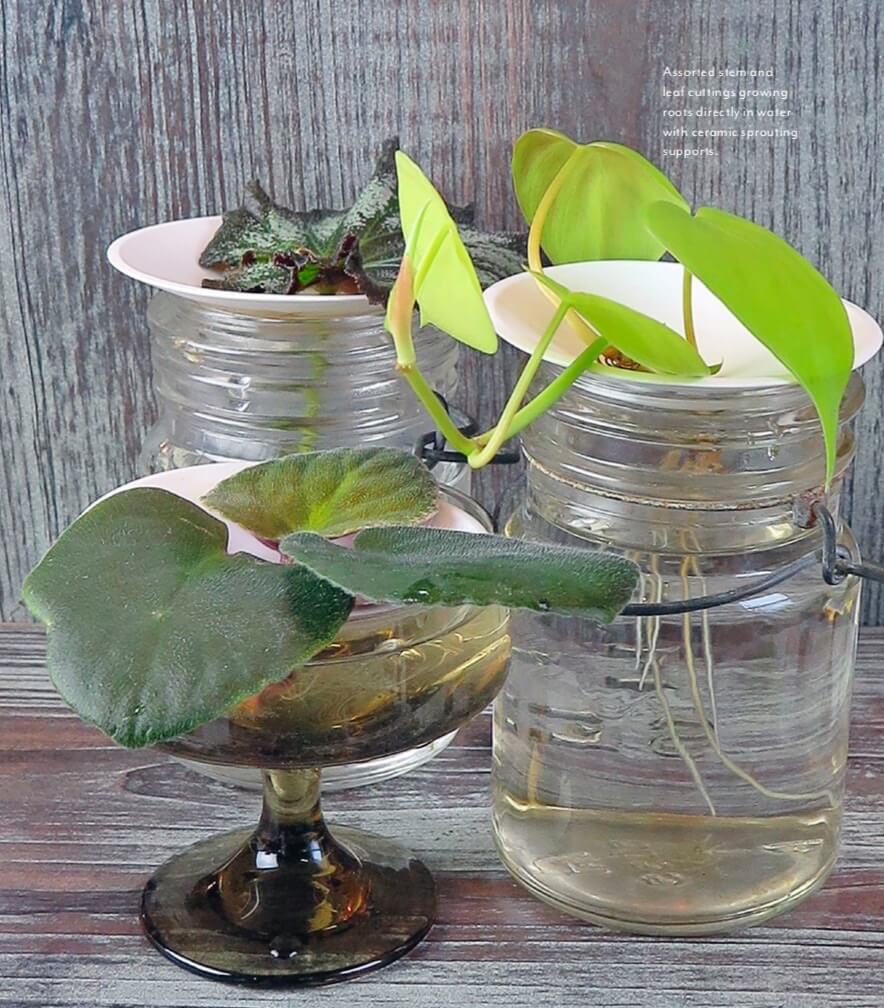
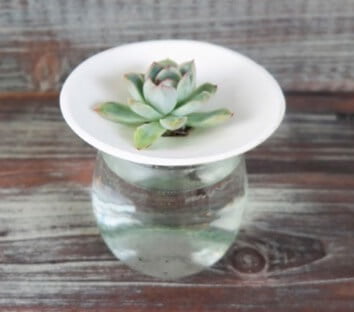
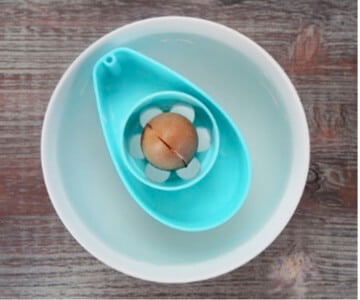
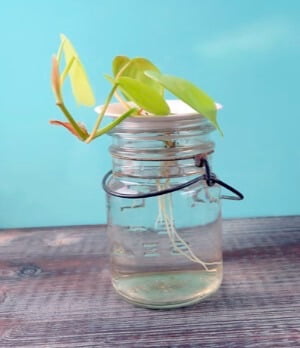
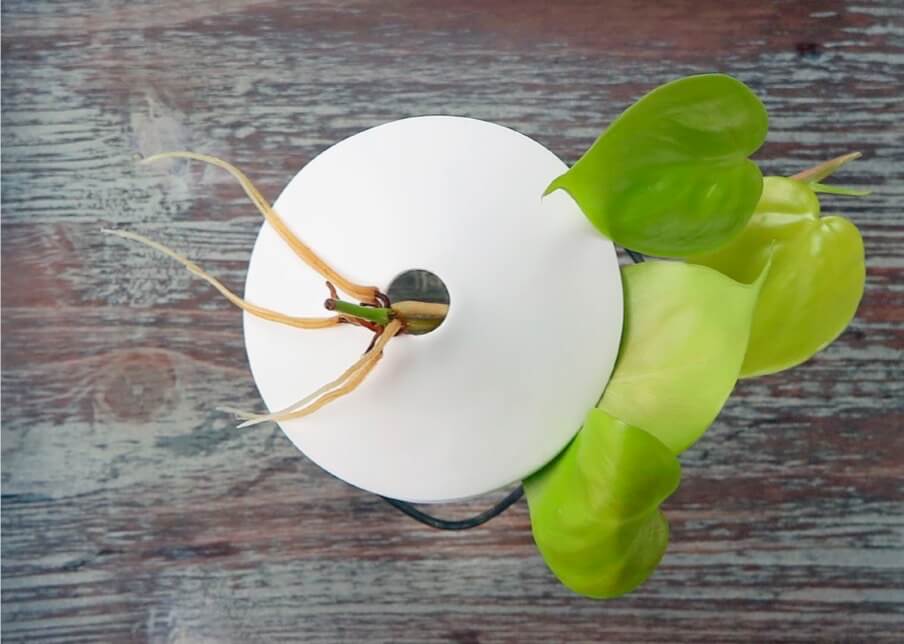
Tiếng Việt
Ra rễ trong nước thường là phương pháp hàng đầu được những người quan tâm đến nhân giống lựa chọn. Chắc hẳn hầu hết các bạn đều đã từng thấy mẹ hoặc bà ngoại cắm những thân cây bén rễ trong lọ thủy tinh trên bệ cửa sổ, kết hợp với một hoặc hai hạt bơ để ngắm cho vui. Có thể bạn đã từng thử nhân giống cây trồng bằng cách giâm cành trong nước khi học một số môn học về cây trồng ở trường.
Thật may mắn, nhiều cây giâm cành và một số hạt giống không cần đất hoặc hỗn hợp bầu để ra rễ và phát triển cây mới, tất cả những gì chúng cần là nước. Những hạt lớn, chẳng hạn như hạt bơ hoặc quả sồi, có thể được đặt lơ lửng một phần trong nước, chúng sẽ nảy mầm ra rễ mới tại vị trí tiếp xúc với nước. Bạn có thể ngâm trước những hạt lớn trước khi ươm hạt bằng phương pháp ra rễ trong nước.
Sử dụng phương pháp giâm cành sinh dưỡng đối với nhiều loại cây có thể ra rễ bằng cách nhúng trực tiếp thân cây vào nước. Tôi khuyên bạn nên sử dụng hom thân mềm, nhiều thịt và hom lá (chúng ta sẽ thảo luận chi tiết trong chương tiếp theo). Nhiều loại cây trồng nhiệt đới trong nhà và các loại cây thân gỗ lâu năm trong vườn có thể mọc rễ dễ dàng trong nước. Trên thực tế, bạn có thể giâm rễ nhiều loại hom thân và lá trong cả nước và đất hoặc các chất trồng khác. Tùy thuộc vào loại cây, việc ra rễ trong nước thường có thể nhanh hơn so với ra rễ bằng đất, và việc quan sát cành giâm ra rễ trong nước sẽ thú vị hơn nhiều.
Thông thường, thực vật thân gỗ và bán thân gỗ khó bén rễ trong môi trường nước hơn, vì nó thường bị thối rữa trước khi ra rễ. Thường thì bạn sẽ dễ thành công khi giâm cành cây thân gỗ hoặc thân cứng (tức là cây có múi, cây dành dành, hoa Hồng, và các loại cây bụi khác) bằng cách sử dụng chất trồng hữu cơ hoặc tổng hợp, hoặc máy nhân giống khí canh (vô tính).
Tất cả những gì bạn cần là một bệ cửa sổ để lấy ánh sáng cho hầu hết các cành giâm rễ trong nước. Cho đến khi cành giâm phát triển rễ và sẵn sàng để cấy ghép, điều kiện ánh sáng yếu sẽ thích hợp cho những hom sinh dưỡng này. Khi cành giâm đã phát triển rễ và sẵn sàng để cấy ghép, bạn cần chuyển chúng đến vị trí có điều kiện ánh sáng mà cây ưa thích như bình thường. Nếu bạn đang ươm mầm những hạt lớn trong nước, chẳng hạn như Bơ, hãy nhớ rằng cây con cần ánh sáng rực rỡ hơn so với cành giâm sinh dưỡng. Đảm bảo đặt cây Bơ mới mọc ở cửa sổ sáng hoặc sử dụng đèn trồng.
Sử dụng bất kỳ loại bình thủy tinh hoặc thùng trong suốt nào bạn muốn để giâm cành hoặc ươm hạt giống trong nước, chẳng hạn như lọ thủy tinh, bình hoa, ống nghiệm, thủy tinh martini. Tất cả những vật dụng này đều phù hợp để ươm hạt hoặc giâm cành trong nước. Ngoài ra, bạn có thể sử dụng một số phụ kiện kèm theo để quá trình nhân giống bằng nước thành công hơn.
Giá đỡ nảy mầm bằng gốm và sứ nằm trên đỉnh của lọ thủy tinh, hỗ trợ cho việc ươm hạt giống lớn hoặc cành giâm, giúp chúng không bị chìm xuống nước, nhằm ngăn chặn thối rữa. Những giá đỡ ươm mầm này cũng tiện dụng cho việc tạo rễ và ươm củ.
Phương pháp truyền thống để ươm mầm hạt Bơ trong nước là chọc ba que tăm vào hạt, sau đó treo nó lên trên một lọ thủy tinh. Nếu bạn đang tìm kiếm một phương pháp hiện đại hơn, hãy tìm dụng cụ thả nổi hạt Bơ, có thể giữ hạt và thả nổi trong bát nước.
Khi sử dụng phương pháp ra rễ trong nước, bạn hãy nhớ thay nước mới khi nước trong bình đã đục, cho đến khi cây phát triển đủ rễ. Loại nước bạn sử dụng có thể tạo ra sự khác biệt trong việc cây của bạn mọc rễ và phát triển tốt như thế nào. Nước máy ở thành phố sẽ chứa chorine, chất độc hại cho cây trồng. Các cạnh cháy hoặc nâu dọc theo lá cây có thể là dấu hiệu của nhiễm độc clo. Nước máy cũng thường có chất làm mềm như natri, sẽ làm hỏng cây. Nếu bạn có thể gom nước mưa, bạn sẽ thấy nước mưa rất lý tưởng để giâm cành và ươm hạt mới. Bạn cũng có thể sử dụng nước suối hoặc nước giếng. Tuy nhiên, nếu bạn chỉ có nước máy, hãy tiếp tục và sử dụng. Bạn có thể khử clo tự nhiên trong nước máy bằng cách đặt nó trong một thùng chứa trong suốt dưới ánh sáng tự nhiên trong ít nhất 24 giờ.
Thời gian cần thiết để bén rễ trong nước tùy thuộc vào loại cây bạn đang trồng. Một số loài ra rễ nhanh có thể ra rễ chỉ trong vài ngày, hầu hết các cây sẽ mất vài tuần để phát triển rễ, trong khi những cây khác có thể mất hơn một tháng. Các loại cây thân gỗ phát triển rễ trên không, chẳng hạn như Trầu Bà (philodendron), đặc biệt dễ dàng và nhanh chóng ra rễ trong nước. Cây có thân cứng hơn sẽ lâu ra rễ hơn. Bạn có thể thêm một lượng nhỏ hoóc môn ra rễ, hoặc chất kích thích ra rễ vào nước mà bạn sử dụng để ươm hạt hoặc giâm cành. Đảm bảo làm theo hướng dẫn trên nhãn về lượng sử dụng khi pha với nước.
Khi cây đã phát triển rễ dài từ 1 đến 2 inch và bắt đầu phân nhánh, đã đến lúc bạn nên trồng cây vào một hỗn hợp bầu.












